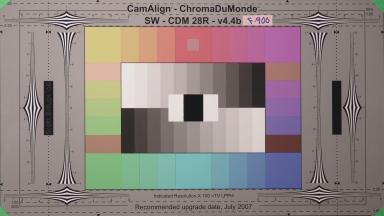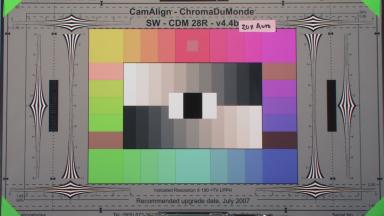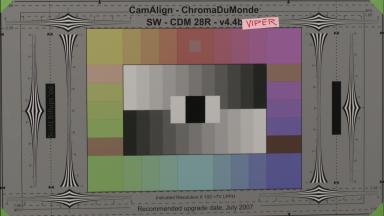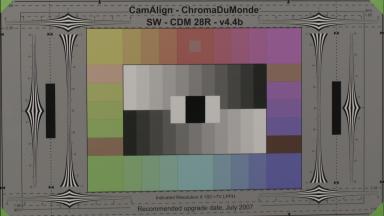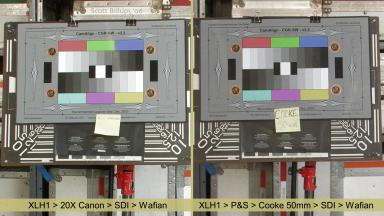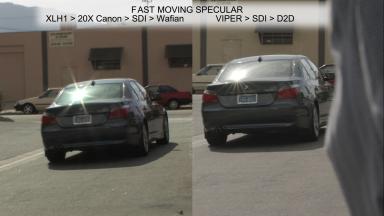These tests were conducted by Scott Billups
As usual click on the image to get a fiull res one.
Test #1 Canon XL H1 with supplied 20X zoom lens vs. Canon XL H1 with P&S adapter and Cooke 50mm cine lens. Both cameras were shooting in 24p (24F) and were captured from their HD-SDI outputs at 4:2:2 chroma and 10 bits of precision as CineForm (Wavelets) Intermediate files into a Wafian HR-1 D2D recorder.
After printing to film and projecting my impression was that the the P&S image had a better depth of field but the noise introduced by the ground glass created problems with compression. Having used the P&S in the field and having enduring the same problems that everyone else has encountered, combined with the compression problems and general softening of the image, I determined that the P&S approach was not viable and am now exploring alternative solutions to mount a manual lens to the XL H1.
The screening of the film out only served to reinforce my impressions.
Test#2 Canon XL H1 with supplied 20X zoom lens & Sony F900 with 16X Canon lens. While not intended as a "shoot-out", this test, when projected took everyone in the theatre by surprise. The Canon XL H1 > SDI > Wafian compared to the F900 > HDCAM > SDI > Wafian was superior, not only to my eye, but to everyone present. I'm sure that if we'd recorded the F900 directly from the SDI that we'd have had a different impression.
Test #3. This test was intended to compare the Viper > 10bit 4:4:4, HD Stream > SDI > D2D (direct to disk via BlackMagic DeckLink HD Pro 4:4:4) at 1.4 Gbsec to Viper > 10bit 4:4:4, HD Stream > SDI > CineForm @ 40Mbsec. ... but by test time, the 4:4:4 Wafian system wasn't ready, so ..... we compaired the Viper > 10bit 4:2:2, HD Stream > SDI > D2D (direct to disk via BlackMagic DeckLink HD Pro 4:4:4) at 600+Mbsec to Viper > 10bit 4:2:2, HD Stream > SDI > CineForm @ 18.5MB/sec (148Mb/sec)
Since we were in the 4:2:2 world, I threw the XL H1 into the mix. Perhaps the most interesting element of the test was the fact that the cleaner the original signal, the more compression it can take and the Viper loves Wavelets.
Also worth noting is that when in 24F mode the XL H1 adds pulldown (redundant fields) to create a 60i signal which it sends out its HD-SDI connector. In software the HR-1 removes the redundant fields (pulldown removal) received over HD-SDI to recover the original 24F signal which is then encoded into 10-bit 24p CineForm Intermediate files.
It seems as though more efficient compression, not bigger and faster storage, is the key to higher quality imaging.
Copyright © CML. All rights reserved.
- aces.png
- aces.png
- aces.png
- aces.png
- 24-7.jpg
- 24-7.jpg
- arri.png
- arri.png
- BandH.jpg
- camalot.png
- camalot.png
- dedo.png
- dsc.png
- dsc.png
- kino.png
- Hawk.png
- JustCinemaGear.jpg
- Leitz_logo.png
- Leitz_logo.png
- Lowing.gif
- Module8Logo.png
- GodoxLogo.png
- Nanlux.png
- NPV_new_logo-(3)-(002).png
- NMBLogoForCML.png
- lindseyo.jpg
- Aputure.png
- TC Logo Centered K_2.png
- VMI.png
- zeiss-logo.png
- zeiss-logo.png
- aces.png
- aces.png
- aces.png
- aces.png
- 24-7.jpg
- 24-7.jpg
- arri.png
- arri.png
- BandH.jpg
- camalot.png
- camalot.png
- dedo.png
- dsc.png
- dsc.png
- FUJINON.jpg
- JustCinemaGear.jpg
- Leitz_logo.png
- Leitz_logo.png
- GodoxLogo.png
- Nanlux.png
- NPV_new_logo-(3)-(002).png
- NMBLogoForCML.png
- FilmLightLogo.png
- theKeep.png
- NewLifeCineLogo.png
- PostWorks.png
- Aputure.png
- TCS.png
- TC Logo Centered K_2.png
- zeiss-logo.png
- zeiss-logo.png
- aces.png
- aces.png
- aces.png
- aces.png
- 24-7.jpg
- 24-7.jpg
- arri.png
- arri.png
- BandH.jpg
- camalot.png
- camalot.png
- dedo.png
- dsc.png
- dsc.png
- kino.png
- Hawk.png
- JustCinemaGear.jpg
- Leitz_logo.png
- Leitz_logo.png
- Lowing.gif
- Module8Logo.png
- GodoxLogo.png
- Nanlux.png
- NPV_new_logo-(3)-(002).png
- NMBLogoForCML.png
- lindseyo.jpg
- Aputure.png
- TC Logo Centered K_2.png
- VMI.png
- zeiss-logo.png
- zeiss-logo.png
- aces.png
- aces.png
- aces.png
- aces.png
- 24-7.jpg
- 24-7.jpg
- arri.png
- arri.png
- BandH.jpg
- camalot.png
- camalot.png
- dedo.png
- dsc.png
- dsc.png
- FUJINON.jpg
- JustCinemaGear.jpg
- Leitz_logo.png
- Leitz_logo.png
- GodoxLogo.png
- Nanlux.png
- NPV_new_logo-(3)-(002).png
- NMBLogoForCML.png
- FilmLightLogo.png
- theKeep.png
- NewLifeCineLogo.png
- PostWorks.png
- Aputure.png
- TCS.png
- TC Logo Centered K_2.png
- zeiss-logo.png
- zeiss-logo.png
- aces.png
- aces.png
- aces.png
- aces.png
- 24-7.jpg
- 24-7.jpg
- arri.png
- arri.png
- BandH.jpg
- camalot.png
- camalot.png
- dedo.png
- dsc.png
- dsc.png
- kino.png
- Hawk.png
- JustCinemaGear.jpg
- Leitz_logo.png
- Leitz_logo.png
- Lowing.gif
- Module8Logo.png
- GodoxLogo.png
- Nanlux.png
- NPV_new_logo-(3)-(002).png
- NMBLogoForCML.png
- lindseyo.jpg
- Aputure.png
- TC Logo Centered K_2.png
- VMI.png
- zeiss-logo.png
- zeiss-logo.png
- aces.png
- aces.png
- aces.png
- aces.png
- 24-7.jpg
- 24-7.jpg
- arri.png
- arri.png
- BandH.jpg
- camalot.png
- camalot.png
- dedo.png
- dsc.png
- dsc.png
- FUJINON.jpg
- JustCinemaGear.jpg
- Leitz_logo.png
- Leitz_logo.png
- GodoxLogo.png
- Nanlux.png
- NPV_new_logo-(3)-(002).png
- NMBLogoForCML.png
- FilmLightLogo.png
- theKeep.png
- NewLifeCineLogo.png
- PostWorks.png
- Aputure.png
- TCS.png
- TC Logo Centered K_2.png
- zeiss-logo.png
- zeiss-logo.png
- aces.png
- aces.png
- aces.png
- aces.png
- 24-7.jpg
- 24-7.jpg
- arri.png
- arri.png
- BandH.jpg
- camalot.png
- camalot.png
- dedo.png
- dsc.png
- dsc.png
- kino.png
- Hawk.png
- JustCinemaGear.jpg
- Leitz_logo.png
- Leitz_logo.png
- Lowing.gif
- Module8Logo.png
- GodoxLogo.png
- Nanlux.png
- NPV_new_logo-(3)-(002).png
- NMBLogoForCML.png
- lindseyo.jpg
- Aputure.png
- TC Logo Centered K_2.png
- VMI.png
- zeiss-logo.png
- zeiss-logo.png
- aces.png
- aces.png
- aces.png
- aces.png
- 24-7.jpg
- 24-7.jpg
- arri.png
- arri.png
- BandH.jpg
- camalot.png
- camalot.png
- dedo.png
- dsc.png
- dsc.png
- FUJINON.jpg
- JustCinemaGear.jpg
- Leitz_logo.png
- Leitz_logo.png
- GodoxLogo.png
- Nanlux.png
- NPV_new_logo-(3)-(002).png
- NMBLogoForCML.png
- FilmLightLogo.png
- theKeep.png
- NewLifeCineLogo.png
- PostWorks.png
- Aputure.png
- TCS.png
- TC Logo Centered K_2.png
- zeiss-logo.png
- zeiss-logo.png

